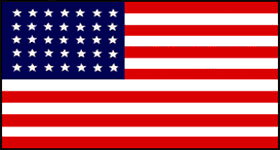 |
Civil War Battles |
|
State War Records |
| AL - AK - AZ - AR - CA - CO - CT - DE - FL - GA - HI - ID - IL - IN - IA - KS - KY - LA - MA - MD - ME - MI - MN - MS - MO - MT - NE - NV - NH - NJ - NM - NY - NC - ND - OH - OK - OR - PA - RI - SC - SD - TN - TX - UT - VT - VA - WA - WV - WI - WY |
The Battle of Mobile
March 25- April 12, 1865 in Mobile, Alabama
 |
|||||||||||||||||||||
|
Overlooking Mobile Bay, one of the major channels through which the Confederacy received its supplies from abroad, Mobile, Alabama is situated 30 miles from the Gulf of Mexico. It was defended by nearly 400 guns in 3 major forts (the most important of which was Fort Morgan) and several batteries, as well as by lines of piles, torpedoes, and numerous floating mines. Mobile was also defended by an inner line of works, principal of which was Spanish Fort, looked upon as the key to the city.
Rear Adm. David G. Farragut wanted to capture Mobile in 1862 after he had taken New Orleans , but it was not until August 5th, 1864 that he stormed into the bay with his fleet. In this effort, Farragut managed to capture Fort Morgan and gain absolute control of the bay, but no attempt was made to move against Mobile.
By March 1865, a new movement had begun against the city, both by land and water. Farragut had retired and in his place was Rear Adm. Henry K. Thatcher; army troops were led by Maj. Gen. E.R.S. Canby. The navy had about 20 ships with which to battle Adm. Franklin Buchanan's 4 ships.
In a cooperative land/sea operation, 1 column moved up the coast on March 17th. while another column moved by water to a point on the other side of the bay. There were to be simultaneous attacks, each drawing attention from the other. In 10 days, the army was near Spanish Fort, while the gunboats were continually bombarding the forts.
On April 4th, the bombardment was stepped up and continued throughout he night at a rate of a shell every 3 or 4 minutes. On the 8th, Spanish Fort was evacuated by the Confederates. Other forts begun to fall, and on the 12th, it was discovered that the Confederates had abandoned all their defenses. A formal demand was made for the surrender of Mobile and, at 12:30 P.M. that day, the U.S. flag was raised over city hall.
By the Union had paid a high price for its victory. Nine vessels, large and small, had been sunk by torpedoes and mines, taking the lives of 114 men.
